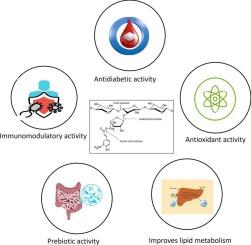Wheat arabinoxylans: Insight into structure-function relationships
IF 10.7
1区 化学
Q1 CHEMISTRY, APPLIED
引用次数: 0
Abstract
Arabinoxylan (AX), a key non-starch polysaccharide found in the cell walls of cereals like wheat, holds significant importance in the food industry. Recently, it has attracted attention due to its numerous health benefits. While the benefits of wheat arabinoxylans are well-established, a more comprehensive understanding of the relationship between their structure and functional properties is essential. This knowledge will be instrumental in addressing potential concerns in future research focusing on food products containing wheat arabinoxylan. Previous reviews predominantly focused on cereal arabinoxylans, and only a few have addressed wheat arabinoxylan. This review aims to consolidate recent research findings on wheat arabinoxylans, highlighting their health benefits and potential links to structural variations. This will aid future studies in this area. Feruloylated arabinoxylans and arabinoxylan oligosaccharides stand out as the most known for their health benefits. Modifying the chemical structure of arabinoxylans to yield low molecular weight oligosaccharides enhances their immunomodulatory and antioxidant activities, as well as promotes the growth and availability of beneficial gut microbes. The antioxidant activity is positively correlated with the ferulic acid content, whereas it has a negative correlation with arabinose substitution. Nevertheless, additional research using final products is necessary to delve into the potential underlying mechanisms.

小麦阿拉伯聚糖:洞察结构-功能关系
阿拉伯木聚糖(AX)是一种主要的非淀粉多糖,存在于小麦等谷物的细胞壁中,在食品工业中具有重要地位。最近,阿拉伯木聚糖因其对健康的诸多益处而备受关注。虽然小麦阿拉伯木聚糖的益处已得到公认,但更全面地了解其结构和功能特性之间的关系至关重要。这些知识将有助于解决未来研究含小麦阿拉伯木聚糖食品时可能出现的问题。以往的综述主要关注谷物阿拉伯木聚糖,只有少数综述涉及小麦阿拉伯木聚糖。本综述旨在整合有关小麦阿拉伯木聚糖的最新研究成果,强调其对健康的益处以及与结构变异的潜在联系。这将有助于今后在这一领域的研究。阿魏酰化阿拉伯木聚糖和阿拉伯木聚糖低聚糖因其对健康的益处而闻名于世。改变阿拉伯木聚糖的化学结构以产生低分子量的低聚糖,可增强其免疫调节和抗氧化活性,并促进有益肠道微生物的生长和利用。抗氧化活性与阿魏酸含量呈正相关,而与阿拉伯糖替代物呈负相关。不过,有必要使用最终产品进行更多研究,以深入探讨潜在的内在机制。
本文章由计算机程序翻译,如有差异,请以英文原文为准。
求助全文
约1分钟内获得全文
求助全文
来源期刊

Carbohydrate Polymers
化学-高分子科学
CiteScore
22.40
自引率
8.00%
发文量
1286
审稿时长
47 days
期刊介绍:
Carbohydrate Polymers stands as a prominent journal in the glycoscience field, dedicated to exploring and harnessing the potential of polysaccharides with applications spanning bioenergy, bioplastics, biomaterials, biorefining, chemistry, drug delivery, food, health, nanotechnology, packaging, paper, pharmaceuticals, medicine, oil recovery, textiles, tissue engineering, wood, and various aspects of glycoscience.
The journal emphasizes the central role of well-characterized carbohydrate polymers, highlighting their significance as the primary focus rather than a peripheral topic. Each paper must prominently feature at least one named carbohydrate polymer, evident in both citation and title, with a commitment to innovative research that advances scientific knowledge.
 求助内容:
求助内容: 应助结果提醒方式:
应助结果提醒方式:


